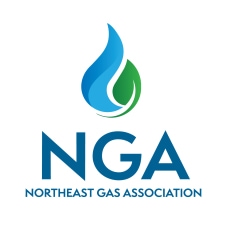Natural Gas and Climate Change
Natural gas is a key part of the U.S. energy system, representing one-third of total energy consumed in 2020. It is a lower-carbon fuel than other fossil fuels, such as oil or coal, and has helped the U.S. achieve environmental progress in recent decades. In the future, it can continue to play an important sustaining role in the U.S. energy system and economy by supporting the integration of "clean energy" resources, and providing a reliable and cost-effective energy source.
As a fossil fuel, natural gas does contribute to carbon emissions, including methane. The natural gas sector is working to lower its carbon output and be part of the needed solution to environmental challenges facing the U.S. and the globe.
A review of natural gas's potential to address the nation's climate change challenge is provided in this summary.
Natural Gas: Less Carbon Intensive than other Fossil Fuels
Natural gas is composed primarily of methane. As described by U.S. EPA: "Natural gas is a fossil fuel formed when layers of buried plants and animals are exposed to intense heat and pressure over thousands of years. The energy that the plants and animals originally obtained from the sun is stored in the form of carbon in natural gas."
Natural gas has lower emissions of carbon dioxide than other fossil fuels such as coal and oil. Compared to coal, natural gas produces half as much carbon dioxide, and about 30% less than oil.
Advantages for Transportation Sector
Natural gas represents an efficient alternative transportation fuel for the U.S. and the Northeast region. Natural gas vehicles employ a technology that is available now and applicable to taxis, passenger vehicles, heavy-duty trucks and buses. Natural gas vehicles provide lower emissions of carbon dioxide, carbon monoxide and nitrogen oxide compared to gasoline and diesel vehicles. (For more information, click here.)
Advantages for Power Generation
For power generation, natural gas has been the leading fuel option in the U.S. and the Northeast over recent years, reflecting the technological advances of natural gas combined cycle power plants, with higher efficiency, lower heat rates, and lower emissions than other fuel options. Natural gas is the least carbon-intensive fossil fuel, and is helping to drive down overall CO2 emissions in the electric power sector.
Natural gas is positioned to remain a reliable and sustaining fuel for electric generation for years to come. Gas also can readily and reliably provide the back-up power generation for intermittent renewable resources like wind and solar power.
In New York State over the last 20 years (from 2000-2021), NY ISO reports that emissions rates from the power sector dropped by 46% for CO2, 92% for NOx, and 99% for SO2. ISO-NE reports that since 2001, total emissions from power plants in New England have dropped by 99% for sulfur dioxide (SO2), 78% for nitrogen oxides (NOx), and 42% for CO2. PJM reports that over the last 16 years, between 2005 and 2021, CO2 emission rates fell 35% across its footprint, while nitrogen oxides declined by 85% and sulfur dioxide by 94%.
Natural gas has been a key factor in all three power systems in helping achieve these environmental gains.

Advantages for Homes and Businesses
For homes and businesses, natural gas also offers opportunities for increased efficiency, reduced emissions, and lower costs. The American Gas Association (AGA) notes: "Natural gas usage per household has decreased even as overall demand for energy has risen. This trend is due in part to the installation of tighter-fitting windows and doors, better insulation, utility-sponsored energy efficiency programs, and the development of increasingly more efficient natural gas appliances."
Efficiency remains a supply resource of immense opportunity to the nation and climate change legislation should encourage cost-effective programs that yield positive results. The Northeast states are national leaders in per capita energy efficiency, and the natural gas and electric utilities in the region have been active for years in efficiency programs. These natural gas efficiency program investments will be expanded even further in coming years. (For more information, click here.)
In a 2017 paper, the National Regulatory Research Institute (NRRI) observed: "For most of the country, natural gas is the most economical energy source for homes and businesses."
Reducing Methane Emissions within
Gas System Operations
Natural gas companies are committed to reducing their own carbon footprint and are actively involved in such initiatives as the U.S. EPA's "Natural Gas STAR" Program to reduce methane
emissions from natural gas system operations. Progress continues on this front, and new technologies are helping in that regard.
NGA encourages increased funding for innovative research and development programs that support improved technologies in all stages of the natural gas supply and delivery chain to achieve
environmental improvements.
More information on Natural Gas STAR can be found here: https://www.epa.gov/natural-gas-star-program/natural-gas-star-program
Natural gas systems are a leading contributor to CH4 or methane emissions in the U.S., along with agriculture, landfills and coal mining. But methane emissions from
natural gas have come down compared to prior decades. CH4 emissions from natural gas systems declined by 15.7% from 1990 to 2021, according to the U.S. EPA's
draft 2021 Greenhouse Gas Inventory released in February 2023. (This decline occurred in a timeframe when total U.S. natural gas consumption grew from 19 Tcf in 1990 to 30 Tcf in
2021 - a growth of 58%, while U.S. dry natural gas production nearly doubled at the same time.)
EPA notes in its draft February 2023 report: "Natural gas systems were the second largest anthropogenic source category of CH4 emissions in the United States in 2021,
accounting for 181.4 MMT CO2 Eq. of CH2 (24.9 percent of total CH4 emissions). Emissions decreased by 33.7 MMT CO2 Eq. (15.7 percent) since
1990 largely due to decreases in emissions from distribution, transmission, and storage... Distribution system emissions, which accounted for 8 percent of CH4 emissions from natural gas
systems and less than 1 percent of CO2 emissions, result mainly from leak emissions from pipelines and stations. An increased use of plastic piping, which has lower emissions
than other pipe materials, has reduced both CH4 and CO2 emissions from this stage, as have station upgrades at metering and regulating (M&R) stations.
Distribution system CH4 emissions in 2020 were 70 percent lower than 1990 levels and 1 percent lower than 2020 emissions. Distribution system CO2 emissions in
2021 were 70 percent lower than 1990 levels and 1 percent lower than 2019 emissions." [EPA, Inventory of U.S. Greenhouse Gas Emissions and Sinks: 1990-2021, pages ES-13 and 3-95]
In the transmission and storage sector, methane emissions are down 30% in this same time period. The production segment was up 45%.
State inventories report similar progress. The Massachusetts DEP's greenhouse gas emissions inventory shows that methane (CH4) emissions from natural gas systems declined by over 70% from 1990 to 2020. Connecticut reports that the contribution of methane emissions from leakage from natural gas distribution and transmission systems within Connecticut is 0.6% of all statewide consumption-based GHG emissions (source: Connecticut 2018 GHG Inventory, released Sept. 2021). According to this report, natural gas system leakage in Connecticut has declined by two-thirds since 1990.
Accelerated pipeline replacement of "leak-prone" system components, such as cast iron and bare steel, is an industry and U.S. DOT priority - see the separate issue brief at: https://www.northeastgas.org/accelerated_infrastructure
New Technology Innovations
Another element of focus for the natural gas industry is utilizing new technology innovations to reduce or offset carbon intensity in supply. These include renewable natural gas (RNG), hydrogen, and carbon capture sequestration.
RNG, also known as bio-methane or biogas, is pipeline quality gas derived from biomass that is fully interchangeable with natural gas. The future natural gas network could include renewable gas from dairy farms, waste water treatment plants, landfills, wood waste and food waste plants. In the Northeast, there is growing interest and initiatives toward incorporating RNG, with several pilot programs underway. Look for further information on NGA's RNG page here: https://www.northeastgas.org/renewable_natural_gas
Among the energy sources seen as potentially significant for helping establish a low-carbon energy future is hydrogen. For natural gas systems, hydrogen has the potential to reduce carbon intensity through blending into existing gas pipeline systems. Look for further information on hydrogen's potential here:



